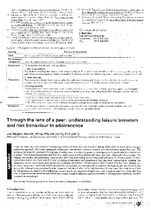| dc.contributor.author | Wegner, Lisa | |
| dc.date.accessioned | 2013-10-10T19:33:01Z | |
| dc.date.available | 2013-10-10T19:33:01Z | |
| dc.date.issued | 2011 | |
| dc.identifier.citation | Wegner, L. (2011). Through the lens of a peer: understanding leisure boredom and risk behaviour in adolescence. South African Journal of Occupational Therapy, 41(1): 18-24 | en_US |
| dc.identifier.issn | 00382337 | |
| dc.identifier.uri | http://hdl.handle.net/10566/736 | |
| dc.description.abstract | There has been very little research investigating leisure boredom and risk behaviour among adolescents in South Africa. Using a qualitative approach, this study investigated adolescents’ perceptions of leisure boredom and risk behaviour during free time. The sample of participants comprised three groups of adolescent: a community group, a school group and a group who had dropped out of school. Participants documented their free time experiences by taking photographs that were later discussed in focus groups. The findings showed that the participants were bored in their free time mainly because they had nothing to do. The low socio-economic environment where they lived contributed to occupational deprivation and imbalance in their free time, maintaining or ‘trapping’ the adolescents within the situation and contributing to feelings of boredom. The participants spent much of their free time ‘hanging out’ on street corners or in backyards, which allowed them to socialise, but inevitably led to boredom. Participants felt that boredom was part of life, although some perceived it to be ‘dangerous’ because it often led to risky behaviour. In conclusion, the study showed that for the participants, leisure is an occupational concern due to the occupational deprivation and imbalance occurring within their free time. Occupational therapists should consider how leisure boredom influences adolescent health, wellbeing and development, and plan interventions accordingly. | en_US |
| dc.language.iso | en | en_US |
| dc.publisher | Occupational Therapy Association of South Africa | en_US |
| dc.rights | ©2011 Occupational Therapy Association of South Africa. Permission has been given to reproduce this file. | |
| dc.subject | Adolescence | en_US |
| dc.subject | Free time | en_US |
| dc.subject | Leisure boredom | en_US |
| dc.subject | Photographs | en_US |
| dc.subject | Risk behaviour | en_US |
| dc.title | Through the lens of a peer: understanding leisure boredom and risk behaviour in adolescence | en_US |
| dc.type | Article | en_US |
| dc.privacy.showsubmitter | false | |
| dc.status.ispeerreviewed | true | |
| dc.description.accreditation | Department of HE and Training approved list | en_US |

